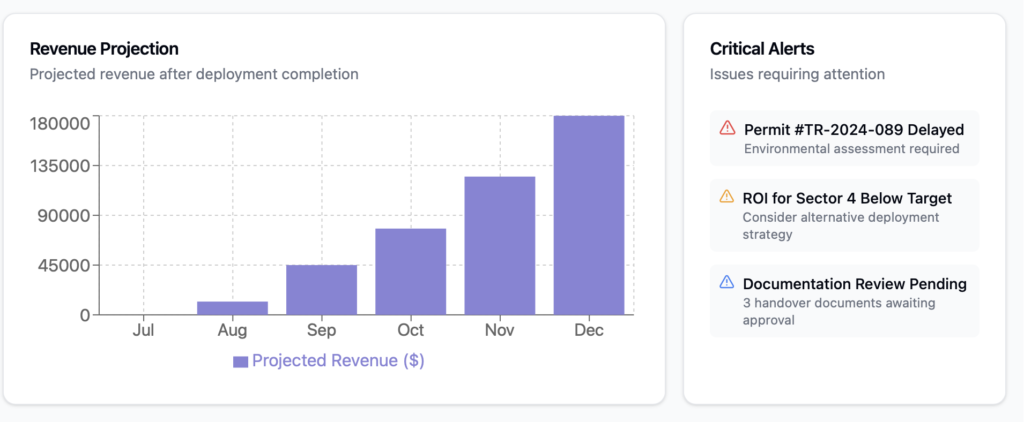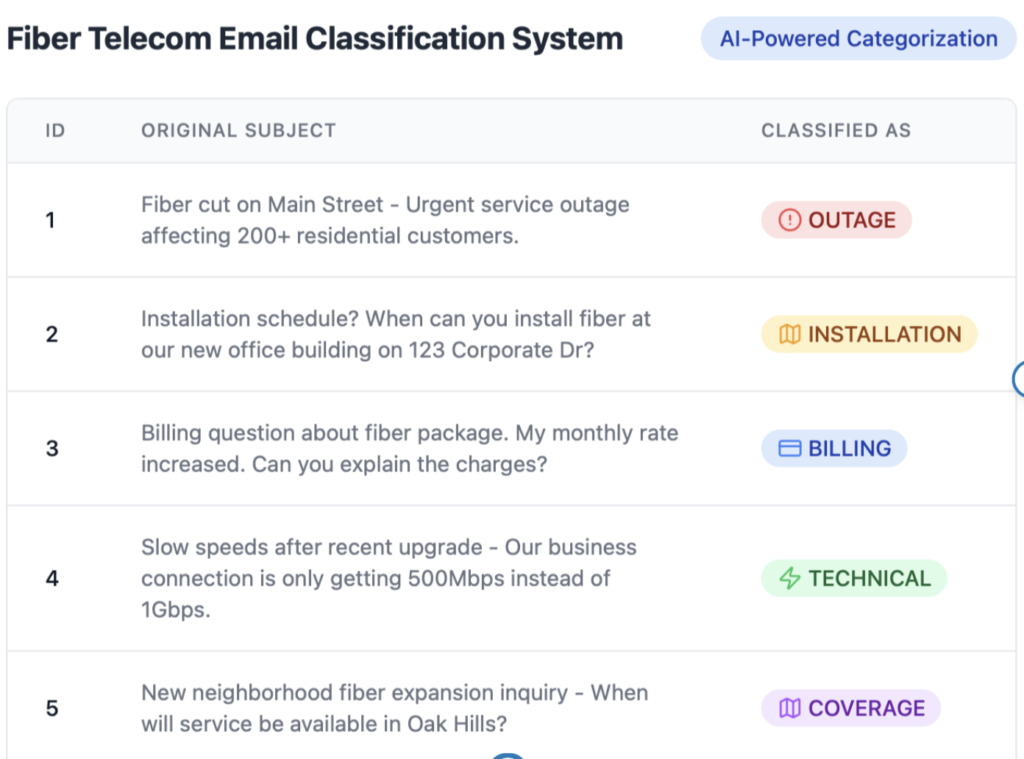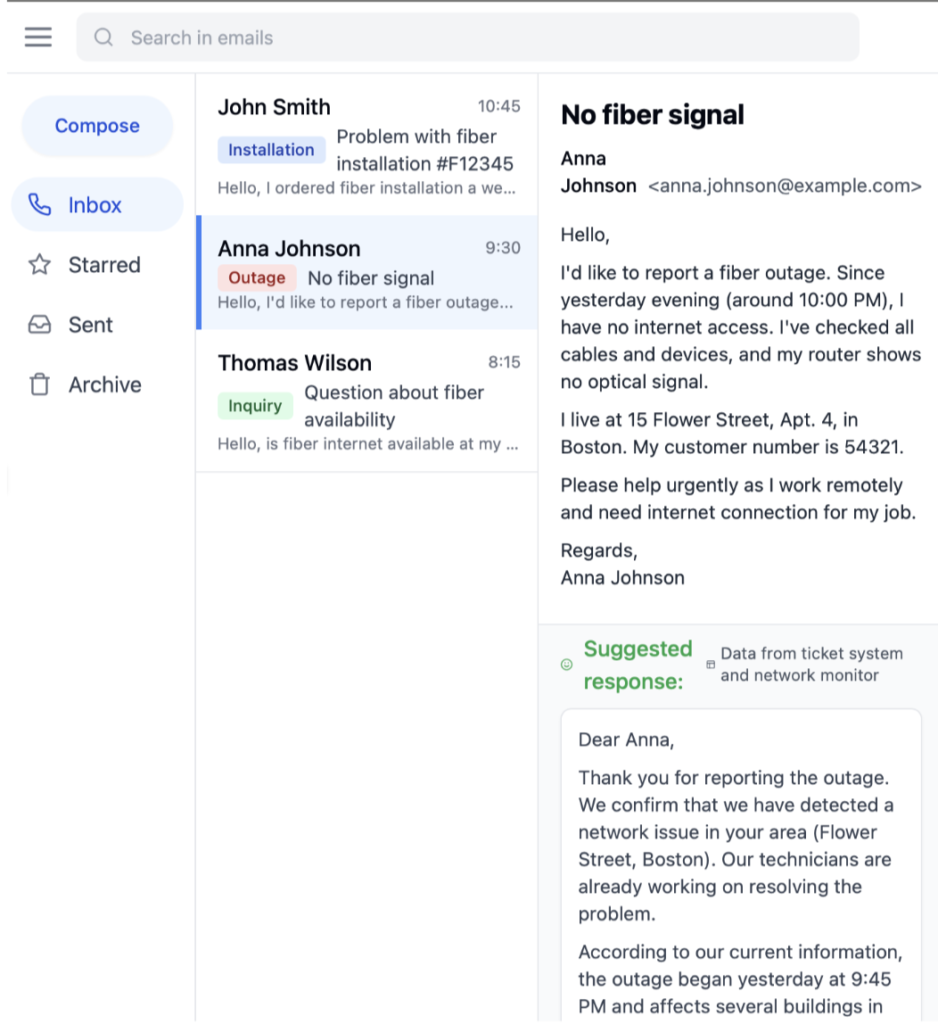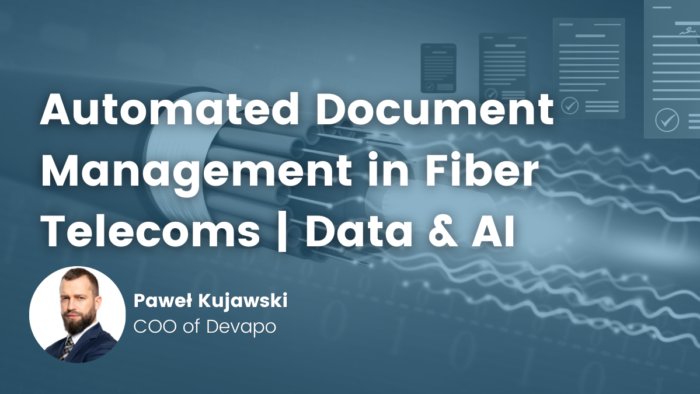- Paweł Kujawski
- Read in 5 min.
Managing sheer volume of partner agreements, SLAs, technical specifications, invoices, budgets and plans created significant operational challenges in many telecoms we’ve worked with. This article explores how with the rapid evolution of AI technologies, telcos now have powerful tools to revolutionize how they handle information. AI-powered document analysis is delivering measurable business value specifically for telecom infrastructure providers.
- Thousands of hours saved a year
- More than ever structured and accessible information
- Up to 40% faster document management
This is how your document management can look like soon. Let’s see some examples.
Network Operations: Finding Gold in Your Data for Wholesale Improvement
Networks continuously generate valuable data, but without the right tools, much of it remains untapped. Modern telcos are leveraging this data not only to drive smarter decisions but also to generate new leads.
By integrating internal network data with external datasets—such as urban planning proposals—telcos can gain a more comprehensive view of their operations. Automated performance reports can be created that don’t just show what happens but highlight why it matters. These reports identify network bottlenecks while uncovering opportunities, such as underutilized segments near new housing developments, where strategic expansion can deliver quick wins.
For marketing teams these data can be powerful ammunition for targeting operators looking to buy access.
- Targeted Geographic Expansion – Conducting FTTH penetration analytics to assess Fiber-to-the-Home coverage potential in adjacent territories, helping operators identify opportunities to leverage existing infrastructure for maximum benefit.
- Capacity Availability Maps – Showcase where are robust, underutilized capacity that meets operations growth needs.
By transforming technical network data into compelling business opportunities, you can significantly increase interest from operators seeking reliable access partners and maximize the value of your existing infrastructure investments.
Network Documentation: Turning Paper into Performance
Let’s be honest — most fiber companies are drowning in documentation that’s rarely used effectively. AI-powered systems now extract critical information automatically, generating practical business value.
- Maintenance schedules buried in technical documentation can become overlooked issues, preventing proactive measures that could avert service interruptions before they happen.
- Network topology visualizations transform complex documentation into intuitive maps that everyone can understand, not just your senior engineers.
How can it be used in FPM and FSM? Given that most infrastructure providers point to these challenges when launching network infrastructure projects, we can provide some answers.
Source: Orange Wholesale Market Report 2024.
Field Project Management: Accelerating Deployment
Permit applications, cost analyses, and project documentation might not sound exciting, but they directly impact how quickly you can deploy and monetize new fiber. AI systems now:
- Manage handover documentation and approval workflows, accelerating time to revenue.
- Streamline preparation and processing of regulatory permits, reducing delays and ensuring compliance.
- Analyze the cost and profitability of planned investments across multiple scenarios, helping you identify the most economically viable approaches.


Field Service Management: Optimizing Your Most Expensive Resource
Your field technicians represent both a crucial asset and a significant expense. Optimizing their time delivers immediate benefits.
Predictive resource planning forecasts parts requirements and technical expertise needed. Imagine a system that based on thousands of documents can within a blink of an eye notify you that the expiry date of one component is coming. Your employees could be send before shortages occur.
RFP Processes: From Time Sink to Strategic Advantage
If your company is like most fiber operators we’ve worked with, your RFP process is probably consuming dozens if not hundreds of valuable hours. Here’s how AI is transforming this:
Your previous RFPs contain patterns of success and failure that AI can now extract automatically. Instead of starting from scratch each time, systems analyze historical RFPs to identify what worked best. This intelligence powers the generation of optimized templates that incorporate your company’s specific requirements and industry best practices.
When vendor responses start flowing in, comparing complex technical proposals is no longer a week-long exercise. AI comparison tools assess proposed solutions against standardized criteria simultaneously, highlighting critical differences that might otherwise be overlooked.
Streamlining Finance Document Management with AI: From Chaos to Clarity
Invoices and procurement requests are critical for business operations, yet managing them can be time-consuming, error-prone, and inefficient—especially as companies grow. Different formats, approval processes, and integration needs often lead to delays and mistakes. In one of our customers we’ve implemented Devapo Document Management Workflow Solutions which provides automation that simplifies and optimizes these processes, ensuring accuracy and efficiency.
1. Cost Invoice Workflow This solution automates the entire invoice handling process—from retrieving emails with invoice attachments to recognizing content with AI solutions. It then initiates approval workflows at each stage and seamlessly integrates with accounting systems.
2. Investment Request Workflow Designed for project-based investment requests. This system streamlines submissions and approvals. It integrates directly with the internal Project Office System and ERP systems via API, ensuring smooth data flow and transparency.
3. Investment Invoice Workflow Similar to cost invoice automation, this solution processes investment-related invoices by extracting content, managing approvals, and ensuring accurate accounting entries.
4. Grant Documentation Management The necessity of grant refunds (likely due to documentation errors) can create significant financial setbacks. Our system can ensure complete compliance with funding requirements. The solution may automatically flag missing or inconsistent information about missing documents, incorrect formats, or inconsistencies in reporting. By maintaining proper documentation trails and validation checkpoints, businesses dramatically reduce the risk of having to return grant funds due to administrative errors.
Automation of correspondence on emails example
Picture this: your team arrives each morning to find all incoming communications already sorted by priority and type. Network outage reports are instantly routed to operations teams, while equipment orders go directly to procurement. For straightforward issues, the system even generates responses automatically by pulling relevant information from your network documentation, equipment specifications, and maintenance protocols.
Telecom infrastructure providers face a daily deluge of emails across technical support, equipment orders, outage reports, maintenance scheduling, and compliance inquiries. With the help of an LLM, these emails can be automatically sorted and prioritized based on content, making it simple to direct each email to the right department for faster response. LLM pulls relevant information and creates tailored replies, making the process even more efficient.


Getting Started: Your Next Steps
The telecommunications companies seeing the best results aren’t taking an all-or-nothing approach. Instead, they’re identifying specific pain points and implementing targeted solutions with measurable outcomes.
Start by asking your team these three questions:
- What is the condition of our data? Here you can find out about best practices managing telco data.
- Which processes consume the most hours of skilled employee time?
- Which process caused us the biggest financial losses?
The answers will point you toward your highest-value opportunities for automation, data, and AI implementation.
Want to navigate these challenges? Consult our experts and chart your Data & AI strategy.
Summary
The fiber telecommunications companies that thrive in the next decade won’t necessarily be those with the most infrastructure — they’ll be the ones that operate most efficiently and respond most quickly to market demands.
Automation, data analytics, and AI aren’t just nice-to-have technologies anymore; they’re the essential toolkit for building a competitive fiber telecommunications business. The companies implementing these solutions today are already seeing reduced costs, accelerated growth, and improved customer satisfaction.
Leverage the power of Data & AI in Your Telecom
Implement modern data platform and become data-driven organization







